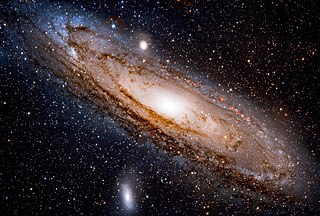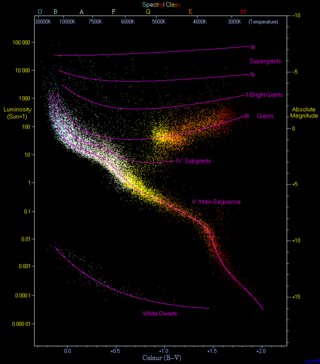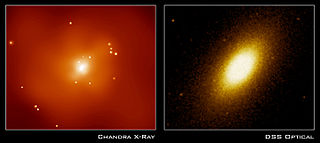Related Research Articles

Dark matter is a hypothetical form of matter thought to account for approximately 85% of the matter in the universe. Dark matter is called "dark" because it does not appear to interact with the electromagnetic field, which means it does not absorb, reflect, or emit electromagnetic radiation and is, therefore, difficult to detect. Various astrophysical observations – including gravitational effects which cannot be explained by currently accepted theories of gravity unless more matter is present than can be seen – imply dark matter's presence. For this reason, most experts think that dark matter is abundant in the universe and has had a strong influence on its structure and evolution.
The study of galaxy formation and evolution is concerned with the processes that formed a heterogeneous universe from a homogeneous beginning, the formation of the first galaxies, the way galaxies change over time, and the processes that have generated the variety of structures observed in nearby galaxies. Galaxy formation is hypothesized to occur from structure formation theories, as a result of tiny quantum fluctuations in the aftermath of the Big Bang. The simplest model in general agreement with observed phenomena is the Lambda-CDM model—that is, that clustering and merging allows galaxies to accumulate mass, determining both their shape and structure.

The Andromeda Galaxy, also known as Messier 31, M31, or NGC 224 and originally the Andromeda Nebula, is a barred spiral galaxy with the diameter of about 46.56 kiloparsecs approximately 765 kpc from Earth and the nearest large galaxy to the Milky Way. The galaxy's name stems from the area of Earth's sky in which it appears, the constellation of Andromeda, which itself is named after the princess who was the wife of Perseus in Greek mythology.

The rotation curve of a disc galaxy is a plot of the orbital speeds of visible stars or gas in that galaxy versus their radial distance from that galaxy's centre. It is typically rendered graphically as a plot, and the data observed from each side of a spiral galaxy are generally asymmetric, so that data from each side are averaged to create the curve. A significant discrepancy exists between the experimental curves observed, and a curve derived by applying gravity theory to the matter observed in a galaxy. Theories involving dark matter are the main postulated solutions to account for the variance.

Messier 87 is a supergiant elliptical galaxy in the constellation Virgo that contains several trillion stars. One of the largest and most massive galaxies in the local universe, it has a large population of globular clusters — about 15,000 compared with the 150–200 orbiting the Milky Way — and a jet of energetic plasma that originates at the core and extends at least 1,500 parsecs, traveling at a relativistic speed. It is one of the brightest radio sources in the sky and a popular target for both amateur and professional astronomers.
In physical cosmology, a protogalaxy, which could also be called a "primeval galaxy", is a cloud of gas which is forming into a galaxy. It is believed that the rate of star formation during this period of galactic evolution will determine whether a galaxy is a spiral or elliptical galaxy; a slower star formation tends to produce a spiral galaxy. The smaller clumps of gas in a protogalaxy form into stars.
A galactic halo is an extended, roughly spherical component of a galaxy which extends beyond the main, visible component. Several distinct components of galaxies comprise the halo:
The cuspy halo problem refers to a discrepancy between the inferred dark matter density profiles of low-mass galaxies and the density profiles predicted by cosmological N-body simulations. Nearly all simulations form dark matter halos which have "cuspy" dark matter distributions, with density increasing steeply at small radii, while the rotation curves of most observed dwarf galaxies suggest that they have flat central dark matter density profiles ("cores").

The dwarf galaxy problem, also known as the missing satellites problem, arises from a mismatch between observed dwarf galaxy numbers and collisionless numerical cosmological simulations that predict the evolution of the distribution of matter in the universe. In simulations, dark matter clusters hierarchically, in ever increasing numbers of halo "blobs" as halos' components' sizes become smaller-and-smaller. However, although there seem to be enough observed normal-sized galaxies to match the simulated distribution of dark matter halos of comparable mass, the number of observed dwarf galaxies is orders of magnitude lower than expected from such simulation.
VIRGOHI21 is an extended region of neutral hydrogen (HI) in the Virgo cluster discovered in 2005. Analysis of its internal motion indicates that it may contain a large amount of dark matter, as much as a small galaxy. Since VIRGOHI21 apparently contains no stars, this would make it one of the first detected dark galaxies. Skeptics of this interpretation argue that VIRGOHI21 is simply a tidal tail of the nearby galaxy NGC 4254.

According to modern models of physical cosmology, a dark matter halo is a basic unit of cosmological structure. It is a hypothetical region that has decoupled from cosmic expansion and contains gravitationally bound matter. A single dark matter halo may contain multiple virialized clumps of dark matter bound together by gravity, known as subhalos. Modern cosmological models, such as ΛCDM, propose that dark matter halos and subhalos may contain galaxies. The dark matter halo of a galaxy envelops the galactic disc and extends well beyond the edge of the visible galaxy. Thought to consist of dark matter, halos have not been observed directly. Their existence is inferred through observations of their effects on the motions of stars and gas in galaxies and gravitational lensing. Dark matter halos play a key role in current models of galaxy formation and evolution. Theories that attempt to explain the nature of dark matter halos with varying degrees of success include cold dark matter (CDM), warm dark matter, and massive compact halo objects (MACHOs).

The red clump is a clustering of red giants in the Hertzsprung–Russell diagram at around 5,000 K and absolute magnitude (MV) +0.5, slightly hotter than most red-giant-branch stars of the same luminosity. It is visible as a denser region of the red-giant branch or a bulge towards hotter temperatures. It is prominent in many galactic open clusters, and it is also noticeable in many intermediate-age globular clusters and in nearby field stars.

The Bullet Cluster consists of two colliding clusters of galaxies. Strictly speaking, the name Bullet Cluster refers to the smaller subcluster, moving away from the larger one. It is at a comoving radial distance of 1.141 Gpc.
The Navarro–Frenk–White (NFW) profile is a spatial mass distribution of dark matter fitted to dark matter halos identified in N-body simulations by Julio Navarro, Carlos Frenk and Simon White. The NFW profile is one of the most commonly used model profiles for dark matter halos.
In astronomy, stellar kinematics is the observational study or measurement of the kinematics or motions of stars through space.
Modified Newtonian dynamics (MOND) is a hypothesis that proposes a modification of Newton's law of universal gravitation to account for observed properties of galaxies. It is an alternative to the hypothesis of dark matter in terms of explaining why galaxies do not appear to obey the currently understood laws of physics.

Cosmic voids are vast spaces between filaments, which contain very few or no galaxies. The cosmological evolution of the void regions differs drastically from the evolution of the Universe as a whole: there is a long stage when the curvature term dominates, which prevents the formation of galaxy clusters and massive galaxies. Hence, although even the emptiest regions of voids contain more than ~15% of the average matter density of the Universe, the voids look almost empty for an observer. Voids typically have a diameter of 10 to 100 megaparsecs ; particularly large voids, defined by the absence of rich superclusters, are sometimes called supervoids. They were first discovered in 1978 in a pioneering study by Stephen Gregory and Laird A. Thompson at the Kitt Peak National Observatory.
Idit Zehavi is an Israeli astrophysicist and researcher who discovered an anomaly in the mapping of the cosmos, which offered insight into how the universe is expanding. She is part of the team completing the Sloan Digital Sky Survey and is one of the world's most highly cited scientists according to the list published annually by Thomson Reuters.

NGC 720 is an elliptical galaxy located in the constellation Cetus. It is located at a distance of circa 80 million light years from Earth, which, given its apparent dimensions, means that NGC 720 is about 110,000 light years across. It was discovered by William Herschel on October 3, 1785. The galaxy is included in the Herschel 400 Catalogue. It lies about three and a half degrees south and slightly east from zeta Ceti.

NGC 4636 is an elliptical galaxy located in the constellation Virgo. It is a member of the NGC 4753 Group of galaxies, which is a member of the Virgo II Groups, a series of galaxies and galaxy clusters strung out from the southern edge of the Virgo Supercluster. It is located at a distance of circa 55 million light years from Earth, which, given its apparent dimensions, means that NGC 4636 is about 105,000 light years across.
References
- ↑ Martinez, Vincent J.; Saar, Enn (2002) [2001]. "Chapter 7: Random Fields in Cosmology". Statistics of the Galaxy Distribution. CRC Press. pp. 232–237. ISBN 978-1-58488-084-4.Note: See section 7.8: Halo Model of Galaxy Clustering
- ↑ Zheng, Zheng; A.A. Berlind; D.H. Weinberg; A.J. Benson; C.M. Baugh; S. Cole; R. Davé; C.S. Frenk; et al. (2005). "Theoretical Models of the Halo Occupation Distribution: Separating Central and Satellite Galaxies". The Astrophysical Journal . 633 (2): 791–809. arXiv: astro-ph/0408564 . Bibcode:2005ApJ...633..791Z. doi:10.1086/466510. S2CID 2286180.
- ↑ Berlind, Andreas A.; David H. Weinberg (2002). "The Halo Occupation Distribution: Toward an Empirical Determination of the Relation between Galaxies and Mass". Astrophysical Journal . 575 (2): 587–616. arXiv: astro-ph/0109001 . Bibcode:2002ApJ...575..587B. doi:10.1086/341469. S2CID 16067136.